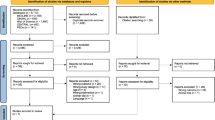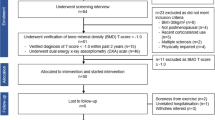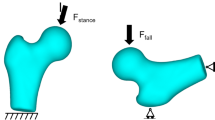Abstract
Summary
We provided evidence that a 6-month regular hopping exercise intervention can increase trabecular number and possibly trabecular volume fraction of the distal tibia. Our novel localised analysis demonstrated region-specific changes, predominantly in the anterior region, in postmenopausal women.
Introduction
The localisation of bone remodelling and microarchitectural adaptation to exercise loading has not been demonstrated previously in vivo in humans. The aim of this study is to assess the feasibility of using 3D image registration and high-resolution peripheral quantitative computed tomography (HR-pQCT) to investigate the effect of high-impact exercise on human trabecular bone variables and remodelling rate across the distal tibia.
Methods
Ten postmenopausal women were recruited for 6-month unilateral hopping exercises, with HR-pQCT scans taken of both exercise leg (EL) and control leg (CL) for each participant before and after the intervention. A 3D image registration was used to ensure measurements were taken at the same region. Short-term reproducibility tests were conducted prior to the assessment using identical setup. The results were assessed comparing CL and EL, and interaction (time × leg) using a two-way repeated measures analysis of variance (RM-ANOVA).
Results
Across the whole tibia, we observed significant increases in trabecular number (Tb.N) (+ 4.4%) and trabecular bone formation rate (tBFR) (3.3%), and a non-significant increase in trabecular bone volume fraction (BV/TV) (+ 1%) in the EL. Regional resorption was higher in the CL than the EL, with this difference being statistically significant at the lateral tibia. In the EL, tBFR was significantly higher in the anterior region than the medial but a trabecular bone resorption rate (tBRR) showed no significant regional variation. Conversely in the CL, both tBFR and tBRR were significantly higher in the anterior and lateral than the medial region.
Conclusion
We demonstrated that it was possible to detect exercise-related bone adaptation with 3D registration of HR-pQCT scan data. Regular hopping exercise increased Tb.N and possibly BV/TV across the whole distal tibia. A novel finding of the study was that tBFR and tBRR responses to loading were localised: changes were achieved by formation rate exceeding resorption rate in the exercise leg, both globally and at the anterior region where turnover was greatest.
Trial registration
clinicaltrials.gov: NCT03225703




Similar content being viewed by others
Data availability
Data and material are not available
References
Consensus development conference (1993) Diagnosis, prophylaxis, and treatment of osteoporosis. Am J Med 94(6):646–650
Lacombe J, Cairns BJ, Green J, Reeves GK, Beral V, Armstrong MEG (2016) The effects of age, adiposity, and physical activity on the risk of seven site-specific fractures in postmenopausal women. J Bone Miner Res 31(8):1559–1568
Crabtree N, Loveridge N, Parker M, Rushton N, Power J, Bell KL et al (2001) Intracapsular hip fracture and the region-specific loss of cortical bone: analysis by peripheral quantitative computed tomography. J Bone Miner Res 16(7):1318–1328
Macdonald HM, Cooper DML, McKay HA (2009) Anterior-posterior bending strength at the tibial shaft increases with physical activity in boys: evidence for non-uniform geometric adaptation. Osteoporos Int 20(1):61–70
Allison SJ, Poole KES, Treece GM, Gee AH, Tonkin C, Rennie WJ et al (2015) The influence of high-impact exercise on cortical and trabecular bone mineral content and 3D distribution across the proximal femur in older men: a randomized controlled unilateral intervention. J Bone Miner Res 30(9):1709–1716
Nishiyama KK, Macdonald HM, Hanley DA, Boyd SK (2013) Women with previous fragility fractures can be classified based on bone microarchitecture and finite element analysis measured with HR-pQCT. Osteoporos Int 24(5):1733–1740
Stuck AK, Schenk D, Zysset P, Bütikofer L, Mathis A, Lippuner K (2020) Reference values and clinical predictors of bone strength for HR-pQCT-based distal radius and tibia strength assessments in women and men. Osteoporos Int 1–11
Sode M, Burghardt AJ, Kazakia GJ, Link TM, Majumdar S (2010) Regional variations of gender-specific and age-related differences in trabecular bone structure of the distal radius and tibia. Bone 46(6):1652–1660
Hughes JM, Gaffney-Stomberg E, Guerriere KI, Taylor KM, Popp KL, Xu C et al (2018) Changes in tibial bone microarchitecture in female recruits in response to 8 weeks of U.S. Army Basic Combat Training. Bone. 113(December 2017):9–16
Kawalilak CE, Johnston JD, Olszynski WP, Kontulainen SA (2014) Characterizing microarchitectural changes at the distal radius and tibia in postmenopausal women using HR-pQCT. Osteoporos Int 25(8):2057–2066
Schulte FA, Lambers FM, Kuhn G, Müller R (2011) In vivo micro-computed tomography allows direct three-dimensional quantification of both bone formation and bone resorption parameters using time-lapsed imaging. Bone. 48(3):433–442
Schulte FA, Ruffoni D, Lambers FM, Christen D, Webster DJ, Kuhn G et al (2013) Local mechanical stimuli regulate bone formation and resorption in mice at the tissue level. PLoS One 8(4):e62172
Ellouz R, Chapurlat R, Van Rietbergen B, Christen P, Pialat J-B, Boutroy S (2014) Challenges in longitudinal measurements with HR-pQCT: evaluation of a 3D registration method to improve bone microarchitecture and strength measurement reproducibility. Bone. 63:147–157
Christen P, Ito K, Ellouz R, Boutroy S, Sornay-Rendu E, Chapurlat RD et al (2014) Bone remodelling in humans is load-driven but not lazy. Nat Commun 5:1–5
Christen P, Boutroy S, Ellouz R, Chapurlat R, Van Rietbergen B (2018) Least-detectable and age-related local in vivo bone remodelling assessed by time-lapse HR-pQCT. PLoS One 13(1):1–11
Hartley C, Folland JP, Kerslake R, Brooke-wavell K (2020) High-impact exercise increased femoral neck bone density with no adverse effects on imaging markers of knee osteoarthritis in postmenopausal women. J Bone Miner Res 35(1):53–63
Clarke B (2008) Normal bone anatomy and physiology. Clin J Am Soc Nephrol 3(Suppl 3):131–139
Eleftheriou KI, Rawal JS, Kehoe A, James LE, Payne JR, Skipworth JR et al (2012) The Lichfield bone study: the skeletal response to exercise in healthy young men. J Appl Physiol 112(4):615–626
Sornay-Rendu E, Boutroy S, Munoz F, Delmas PD (2007) Alterations of cortical and trabecular architecture are associated with fractures in postmenopausal women, partially independent of decreased BMD measured by DXA: the OFELY study. J Bone Miner Res 22(3):425–433
Paggiosi MA, Eastell R, Walsh JS (2014) Precision of high-resolution peripheral quantitative computed tomography measurement variables: influence of gender, examination site, and age. Calcif Tissue Int 94(2):191–201
Metcalf LM, Dall’Ara E, Paggiosi MA, Rochester JR, Vilayphiou N, Kemp GJ et al (2018) Validation of calcaneus trabecular microstructure measurements by HR-pQCT. Bone. 106:69–77
Du J, Brooke-Wavell K, Paggiosi MA, Hartley C, Walsh JS, Silberschmidt VV et al (2019) Characterising variability and regional correlations of microstructure and mechanical competence of human tibial trabecular bone: an in-vivo HR-pQCT study. Bone 121(January):139–148
Singh AK, Lobo Gajiwala A, Rai RK, Khan MP, Singh C, Barbhuyan T et al (2016) Cross-correlative 3D micro-structural investigation of human bone processed into bone allografts. Mater Sci Eng C 62:574–584
Doube M, Kłosowski MM, Arganda-Carreras I, Cordelières FP, Dougherty RP, Jackson JS et al (2010) BoneJ: free and extensible bone image analysis in ImageJ. Bone. 47(6):1076–1079
Hildebrand T, Rüegsegger P (1997) A new method for the model-independent assessment of thickness in three-dimensional images. J Microsc 185(1):67–75
Whittier D.E., Boyd S.K., Burghardt A.J., Paccou J., Chapurlat R., Engelke K. Guidelines for the assessment of bone density and microarchitecture in vivo using high-resolution peripheral quantitative computed tomography. Osteoporos Int a J Establ as Result Coop Between Eur Found Osteoporos Natl Osteoporos Found USA 2020
Lorensen WE, Cline HE (1987) Marching cubes: a high resolution 3D surface construction algorithm. ACM Siggraph Comput Graph 21(4):163–169
Doube M (2015) The ellipsoid factor for quantification of rods, plates, and intermediate forms in 3D geometries. Front Endocrinol (Lausanne) 6:15
Chai X, van Herk M, Hulshof MCCM, Bel A (2011) A voxel-based finite element model for the prediction of bladder deformation. Med Phys 39(1):55–65
Klintström E, Klintström B, Moreno R, Brismar TB, Pahr DH, Smedby Ö (2016) Predicting trabecular bone stiffness from clinical cone-beam CT and HR-pQCT data: an in vitro study using finite element analysis. PLoS One 11(8):e0161101
Burr DB, Milgrom C, Fyhrie D, Forwood M, Nyska M, Finestone A et al (1996) In vivo measurement of human tibial strains during vigorous activity. Bone. 18(5):405–410
Lim CT, Ng DQK, Tan KJ, Ramruttun AK, Wang W, Chong DYR (2016) A biomechanical study of proximal tibia bone grafting through the lateral approach. Injury 47(11):2407–2414
Christen P, Müller R (2017) In vivo Visualisation and quantification of bone resorption and bone formation from time-lapse imaging. Curr Osteoporos Rep 15(4):311–317
Lambers FM, Kuhn G, Weigt C, Koch KM, Schulte FA, Müller R (2015) Bone adaptation to cyclic loading in murine caudal vertebrae is maintained with age and directly correlated to the local micromechanical environment. J Biomech 48(6):1179–1187
Burghardt AJ, Kazakia GJ, Sode M, De Papp AE, Link TM (2010) Majumdar S. A longitudinal HR-pQCT study of alendronate treatment in postmenopausal women with low bone density: relations among density, cortical and trabecular microarchitecture, biomechanics, and bone turnover. J Bone Miner Res 25(12):2282–2295
Eriksen EF, Melsen F, Sod E, Barton I, Chines A (2002) Effects of long-term risedronate on bone quality and bone turnover in women with postmenopausal osteoporosis. Bone. 31(5):620–625
Recker RR, Weinstein RS, Chesnut CH, Schimmer RC, Mahoney P, Hughes C et al (2004) Histomorphometric evaluation of daily and intermittent oral ibandronate in women with postmenopausal osteoporosis: results from the BONE study. Osteoporos Int 15(3):231–237
Burt LA, Liang Z, Sajobi TT, Hanley DA, Boyd SK (2016) Sex- and site-specific normative data curves for HR-pQCT. J Bone Miner Res 31(11):2041–2047
Shanbhogue VV, Brixen K, Hansen S (2016) Age- and sex-related changes in bone microarchitecture and estimated strength: a three-year prospective study using HRpQCT. J Bone Miner Res 31(8):1541–1549
Whittier DE, Burt LA, Hanley DA, Boyd SK (2020) Sex- and site-specific reference data for bone microarchitecture in adults measured using second-generation HR-pQCT. J Bone Miner Res 35(11):2151–2158
Gabet Y, Bab I (2011) Microarchitectural changes in the aging skeleton. Curr Osteoporos Rep 9(4):177–183
Sundh D, Nilsson M, Zoulakis M, Pasco C, Yilmaz M, Kazakia GJ et al (2018) High impact mechanical loading increases bone material strength in postmenopausal women - a 3-month intervention study. J Bone Miner Res 33(7):1242–1251
Lai YM, Qin L, Yeung HY, Lee KKH, Chan KM (2005) Regional differences in trabecular BMD and micro-architecture of weight-bearing bone under habitual gait loading - a pQCT and microCT study in human cadavers. Bone. 37(2):274–282
Chen H, Zhou X, Fujita H, Onozuka M, Kubo K (2013) Age-related changes in trabecular and cortical bone microstructure. Int J Endocrinol 1–9
Ding M, Hvid I (2000) Quantification of age-related changes in the structure model type and trabecular thickness of human tibial cancellous bone. Bone. 26(3):291–295
Parkinson IH, Fazzalari NL (2013) Characterisation of trabecular bone structure. In: Stud Mechanobiol Tissue Eng Biomater, pp 31–51
Liu XS, Sajda P, Saha PK, Wehrli FW, Bevill G, Keaveny TM et al (2007) Complete volumetric decomposition of individual trabecular plates and rods and its morphological correlations with anisotropic elastic moduli in human trabecular bone. J Bone Miner Res 23(2):223–235
Bailey CA, Brooke-Wavell K (2010) Optimum frequency of exercise for bone health: randomised controlled trial of a high-impact unilateral intervention. Bone 46(4):1043–1049
Cheung AM, Adachi JD, Hanley DA, Kendler DL, Davison KS, Josse R et al (2013) High-resolution peripheral quantitative computed tomography for the assessment of bone strength and structure: a review by the canadian bone strength working group. Curr Osteoporos Rep 11(2):136–146
de Bakker CMJ, Altman AR, Li C, Tribble MB, Lott C, Tseng W-J, Liu XS (2016) Minimizing interpolation bias and precision error in in vivo μct- based measurements of bone structure and dynamics. Ann Biomed Eng 44(8):2518–2528
Acknowledgements
The authors would like to thank all participants involved in this study as well as Ganggang Xiang, Yaqi Qian and Chenguang Zhao from the Loughborough University, for their contribution in segmenting the images. We would also like to acknowledge the Mellanby Centre for Bone Research at The University of Sheffield and the NIHR Clinical Research Facility, Sheffield Teaching Hospitals, for providing access to the HR-pQCT scanner.
Funding
This study was jointly supported by the Loughborough University Health & Wellbeing Research Challenge Seed Corn fund and the NIHR Leicester Biomedical Research Centre.
Author information
Authors and Affiliations
Corresponding author
Ethics declarations
Conflicts of interest
SL received grant support from Loughborough University. KBW received grant support from NIHR Leicester Biomedical Research Centre. JSW received grant support from National Institute for Health Research. The remaining authors declare no competing financial interests.
Ethics approval
The present study was registered at clinicaltrials.gov: NCT03225703: The Effect of High-Impact Exercise on Bone and Articular Cartilage in Postmenopausal Women.
Consent to participate
All participants provided written informed consent.
Consent for publication
All participants provided written informed consent for publication.
Code availability
Mimics, Abaqus and Matlab were used with official license. Custom code is not available.
Additional information
Publisher’s note
Springer Nature remains neutral with regard to jurisdictional claims in published maps and institutional affiliations.
Rights and permissions
About this article
Cite this article
Du, J., Hartley, C., Brooke-Wavell, K. et al. High-impact exercise stimulated localised adaptation of microarchitecture across distal tibia in postmenopausal women. Osteoporos Int 32, 907–919 (2021). https://doi.org/10.1007/s00198-020-05714-4
Received:
Accepted:
Published:
Issue Date:
DOI: https://doi.org/10.1007/s00198-020-05714-4






